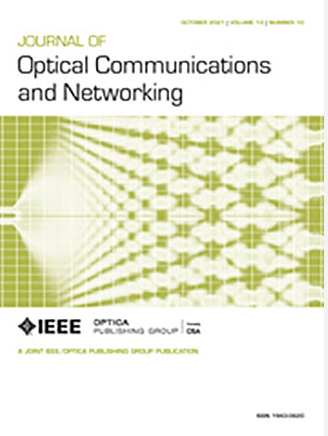基于异构协议的多域量子网络中密钥速率自适应域间密钥业务提供
IF 4.3
2区 计算机科学
Q1 COMPUTER SCIENCE, HARDWARE & ARCHITECTURE
引用次数: 0
摘要
量子密钥分发(QKD)作为面向未来安全的关键技术之一,正朝着大规模网络化的方向发展。由于不同的QKD协议都有各自潜在的优势和不足,因此基于异构协议的城域量子网络互连是实现广域量子网络的重要一步。在这种情况下,域间密钥服务的提供仍然面临成功概率、安全级别和密钥供需平衡等方面的挑战。针对这些挑战,本文提出了四种基于动态节点绕过和弹性SKR切片的密钥速率(SKR)自适应域间密钥服务提供策略,即IrB-IaB(域间绕过和域内绕过)、IrS-IaS(域间切片和域内切片)、IrB-IaS(域间绕过和域内切片)和IrS-IaB(域间切片和域内绕过)。本策略适用于具有异构协议的多域量子网络,如基于gg02的城域连接和基于bb84的域间连接,以及基于bb84的城域连接和基于tf的域间连接。在此基础上,建立了域间密钥服务提供模型,设计了四种相应的自适应skr的域间密钥服务提供算法。仿真结果表明,IrS-IaS算法在成功概率和关键供需均衡程度方面都有较好的表现。通过可信中继的数量定量评估安全级别。IrB-IaB算法实现了最少的可信中继数,比基准算法减少了20%以上,从而实现了更高的安全级别和更低的成本。通过均衡度来评价关键资源的利用效率。IrB-IaS和IrS-IaB算法都有潜力平衡量子网络的有效性和可靠性。特别是,IrS-IaB算法有利于实现关键资源利用效率和安全级别之间的最佳权衡。本文章由计算机程序翻译,如有差异,请以英文原文为准。
Secret key rate-adaptive inter-domain key service provisioning in heterogeneous protocol-based multi-domain quantum networks
Quantum key distribution (QKD), as one of the pivotal technologies for future-proof security, is progressing toward large-scale networking. Since different QKD protocols have their own potential advantages and shortcomings, the interconnection of metropolitan quantum networks based on heterogeneous protocols is an important step to realize a wide-area quantum network. In this scenario, the provision of inter-domain key services still faces challenges in terms of success probability, security level, and the balance between key supply and demand. Targeting these challenges, this work proposes four secret key rate (SKR) adaptive inter-domain key service provisioning policies based on the dynamic node bypass and elastic SKR slicing, namely, IrB-IaB (inter-domain bypass and intra-domain bypass), IrS-IaS (inter-domain slicing and intra-domain slicing), IrB-IaS (inter-domain bypass and intra-domain slicing), and IrS-IaB (inter-domain slicing and intra-domain bypass). The proposed policies are applicable to multi-domain quantum networks with heterogeneous protocols such as GG02-based metropolitan and BB84-based inter-domain connections, as well as BB84-based metropolitan and TF-based inter-domain connections. Furthermore, the inter-domain key service provisioning model is formulated, and four corresponding SKR-adaptive inter-domain key service provisioning algorithms are designed. Simulation results show that the IrS-IaS algorithm performs better in terms of success probability as well as the equilibrium degree between key supply and demand. The security level is quantitatively evaluated through the number of trusted relays. The IrB-IaB algorithm achieves the lowest number of trusted relays, which is more than 20% lower than the benchmark algorithm, resulting in a higher security level and lower cost. The key resource utilization efficiency is assessed via the equilibrium degree. Both the IrB-IaS and IrS-IaB algorithms have the potential to balance the effectiveness and reliability of quantum networks. In particular, the IrS-IaB algorithm is beneficial in achieving the best trade-off between key resource utilization efficiency and security level.
求助全文
通过发布文献求助,成功后即可免费获取论文全文。
去求助
来源期刊
CiteScore
9.40
自引率
16.00%
发文量
104
审稿时长
4 months
期刊介绍:
The scope of the Journal includes advances in the state-of-the-art of optical networking science, technology, and engineering. Both theoretical contributions (including new techniques, concepts, analyses, and economic studies) and practical contributions (including optical networking experiments, prototypes, and new applications) are encouraged. Subareas of interest include the architecture and design of optical networks, optical network survivability and security, software-defined optical networking, elastic optical networks, data and control plane advances, network management related innovation, and optical access networks. Enabling technologies and their applications are suitable topics only if the results are shown to directly impact optical networking beyond simple point-to-point networks.

 求助内容:
求助内容: 应助结果提醒方式:
应助结果提醒方式:


